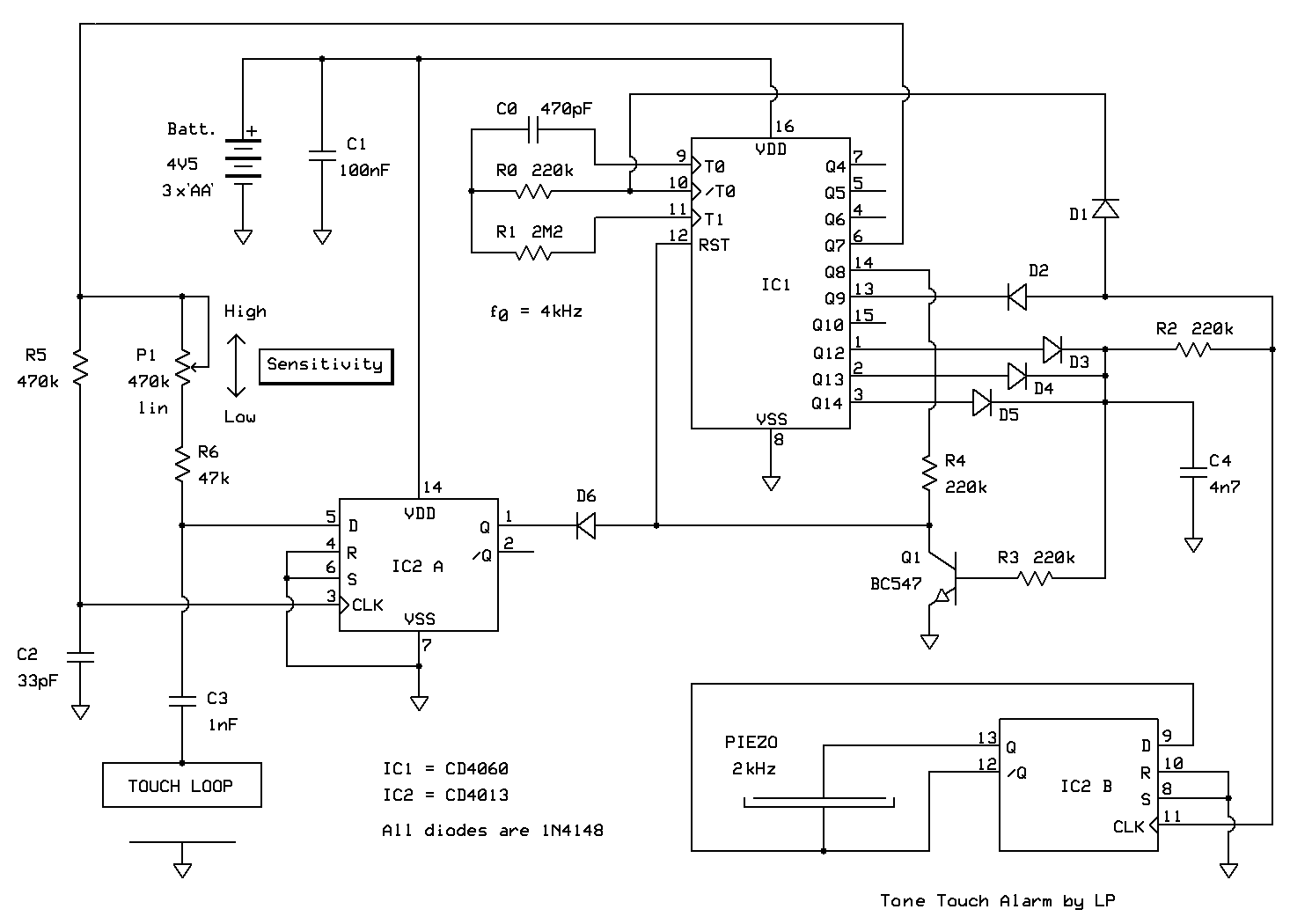We repeat the same circuit diagram here to make understanding the following explanations easier:

What happens after IC2A output Q becomes logic low? If a person is in contact only shortly, or IC2A output got low mistakenly due to an intermittent external disturbance penetrating DATA line, output Q soon gets back to logic high state, so that IC1 resets with no observable effect. But if someone is in contact with the sensitive loop long enough, so that IC2A output Q manages to keep low until IC1 output Q12 becomes logic high, a trespasser is doomed. Q12 turning logic high means that via diode logic (D3 - D5) it activates Q1, which firmly prevents positive reset voltage from reaching pin 12. Once this occurs, IC2A output is of no importance any more - the circuit is unavoidably forced into the alarm routine! Since Q12 divides oscillator frequency by the factor of 2^12, it takes (0.25ms * 2^12) / 2 = 0.5 sec for alarm to take off (Q12 turns logic high at 1/2 of its its entire cycle, this is the reason for division by 2).
Q12 is OR-ed with Q13 and Q14 which means that until all of them become logic low, Q1 will be active preventing pin 12 from resetting IC1. As Q12, Q13 and Q14 are three successive stages of a single binary counter, this means that it takes 2^3 - 1 = 7 half-periods of Q12 = 3.5 seconds for this to occur, as until then at least one of these outputs will be logic high. This defines the duration of the alarm tone generating sequence. Capacitor C4 serves only to prevent Q1 from turning off briefly at instances of time when this 3-stage binary counter changes its state, as for a fraction of microsecond the transition takes place all three outputs may be erroneously logic low.
If all one wants is to get a digital signal informing about touches of the sensitive loop, one can use C4 voltage and process it at will, for example activate a door bell via an optocoupler and a relay etc. But we wanted to generate alarm tones in situ as numerous CD4060 outputs permit so. The idea is to use IC1 oscillator base frequency (4kHz) as a handy digital tone source and Q9 output for controlling it in order to produce short distinctive BEEPs. It works like this: resistor R2 and diodes D1 and D2 form AND logic gate, so that only if all three voltages to which they are connected i.e. C4 voltage and IC1 Q0 and Q9 outputs are logic high, will IC2 CLK input be logic high. Therefore, during the alarm tone generating sequence C4 voltage is gated by Q0 and Q9 outputs which forms bursts of 4kHz signal. It may be a bit easier to understand this if one imagines that constant C4 logic high voltage is firstly On/Off modulated by Q0 output, and then this AF tone signal is On/Off gated by Q9.
This signal is then observed by IC2B CLK input. IC2B operates as a binary frequency divider since its DATA input is tied to its inverted Q output. As a consequence, at IC2B Q output there is a 2kHz beeping tone, which can be used to power a small resonant Piezo loudspeaker. It is useful to remember that inverted Q output is at all times in counter phase to its non-inverted pair, so by connecting the other lead of the loudspeaker to inverted Q output instead to circuit ground, we get 4 times louder alarm tone at no additional cost.
As has already been explained, once the alarm tone generating routine has been activated, releasing the hand from the wired doorknob has no influence on circuit operation - solid 3.5 seconds of beeping alarm cannot be interrupted. Only after IC1 Q12, Q13 and Q14 outputs overrun and turned all-0, does IC1 manage to once again reset itself by the very next Q6 positive pulse propagating into its reset input. The whole story then goes on and on again - if there is still hand contact with the knob, IC1 waits for another 0.5 seconds to start generating alarm tone etc. Taking all this into account, if a person keeps their hand firmly in contact with the knob, the circuit waits for 0.5 before sounding the first alarm tone series for 3.5 sec, then waits once again for 0.5 sec, then sounds another 3.5 seconds of alarm and so on.
Current consumption of the circuit in the passive state is around 75uA at 4.5Vcc. If the circuit uses three “AA” type alkaline cells of good quality as a power source, they should easily last more than a whole year. Both ICs are standard CMOS type meaning that they are able to operate from 3 to 12 Vcc with little difference in circuit characteristics; we have however tested it only with 4.5Vcc so far.
It is very important to note that it is best to power this circuit from batteries, not from AC/DC power supply for two main reasons. The less important one is preventing strong interferences common in AC electric grid from reaching IC2A sensitive DATA input leading to false alarms. But the most important reason is preventing dangerously high voltages from reaching the doorknob or similar object that one wants to wire and another person to touch - please remember that power supplies may suddenly break in unexpected and sometimes lethally dangerous ways and that we really don’t want anyone to get electrocuted!

